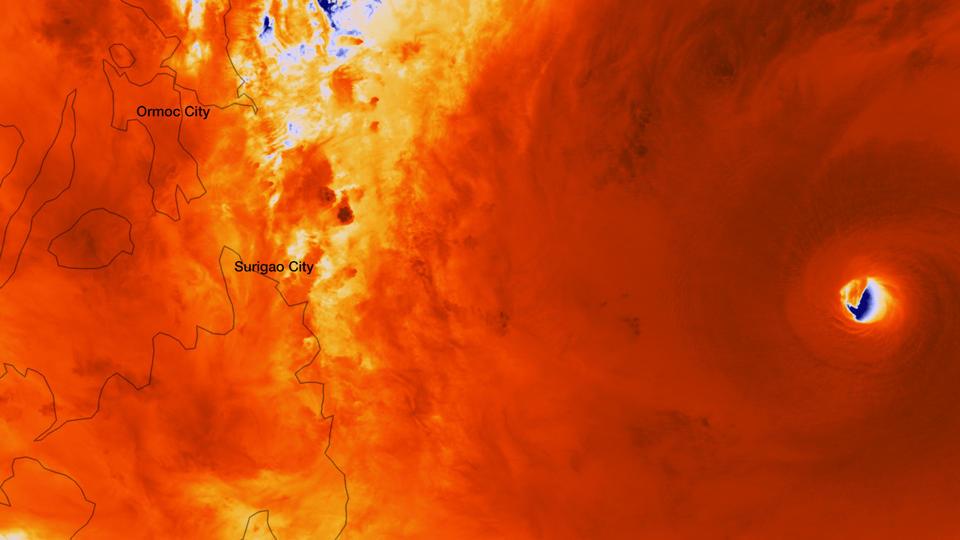November 8, 2013
MANILA, Philippines — One of the most powerful typhoons ever recorded slammed into the Philippines Friday, cutting communications and blocking roads in the center of the country amid worries of serious damage and casualties.

Typhoon Haiyan approaching the Philippines (13:00 UTC November 7, 2013)
November 8, 2013
MANILA, Philippines — One of the most powerful typhoons ever recorded slammed into the Philippines Friday, cutting communications and blocking roads in the center of the country amid worries of serious damage and casualties.

Typhoon Haiyan approaching the Philippines (13:00 UTC November 7, 2013)
Telephone lines appeared down as it was difficult to get through to the landfall site 650 kilometers (405 miles) southeast of Manila where Typhoon Haiyan slammed into a rural area of the country.
Weather officials said that Haiyan had sustained winds at 235 kilometers (147 miles) per hour, with gusts of 275 kph (170 mph) when it made landfall at Eastern Samar province's Guiuan township.
The local weather bureau makes estimates based on longer periods of time than others, such as the U.S. Navy's Joint Typhoon Warning Center, which said shortly before the typhoon made landfall that its maximum sustained winds were 314 kilometers per hour (195 mph), with gusts up to 379 kilometers per hour (235 mph).
"195-mile-per-hour winds, there aren't too many buildings constructed that can withstand that kind of wind," said Jeff Masters, a former hurricane meteorologist who is meteorology director at the private firm Weather Underground.
Masters said the storm had been poised to be the strongest tropical cyclone ever recorded at landfall. He warned of "catastrophic damage."
Haiyan's wind strength at landfall had been expected to beat out Hurricane Camille, which was 305 kph (190 mph) at landfall in the United States in 1969, Masters said.
Already authorities reported having trouble reaching colleagues in the landfall area, with forecaster Mario Palafox of the national weather bureau saying contact had been lost with staff in the landfall area.
More than 125,000 people had been evacuated from towns and villages in the typhoon's path, the National Disaster Risk Reduction and Management Council said. Among them were thousands of residents of Bohol who had been camped in tents and other makeshift shelters after a magnitude 7.2 earthquake devastated many towns on the island province.
Masters said the Philippines might get a small break because the storm is so fast moving that flooding from heavy rains — usually the cause of most deaths from typhoons in the Philippines — may not be as bad.
After hitting Guiuan on the southern tip of Samar island, the typhoon pummeled nearby Leyte island.
"I think this is the strongest so far since the 1960s," Southern Leyte Gov. Roger Mercado said on ABS-CBN television. "This is really a wallop. All roads are impassable due to fallen trees."

This early Thursday, Nov. 7, 2013 satellite image provided by the National Oceanic and Atmospheric Administration shows the eye, right, of Typhoon Haiyan, off the coast of the Philippines, at approximately 05:25 UTC
A reporter for the network in the Tacloban city was drenched in the pounding rain and said he was wearing a helmet as protection against flying debris. Visibility was so poor that only his silhouette could be seen through the thick curtain of water.
Television images showed a street under knee-deep floodwater carrying debris that had been blown down by the fierce winds. Tin roofing sheets ripped from buildings were flying above the street.
Weather forecaster Gener Quitlong said the typhoon was not losing much of its strength because there is no large land mass to slow it down since the region is comprised of islands with no tall mountains.
Officials in Cebu province have shut down electric service to the northern part of the province to avoid electrocutions in case power pylons are toppled, said assistant regional civil defense chief Flor Gaviola.
President Benigno Aquino III assured the public of war-like preparations, with three C-130 air force cargo planes and 32 military helicopters and planes on standby, along with 20 navy ships.
The typhoon — the 24th serious storm to hit the Philippines this year — is forecast to barrel through the Philippines' central region Friday and Saturday before blowing toward the South China Sea over the weekend, heading toward Vietnam.
Courtesy: AP
















































































































